Tiempo Climate Cyberlibrary
Community Adaptation in a Small Island Developing Country
- Tiempo archive
- Complete issues
- Selected articles
- Cartoons
- Climate treaty
- Latest news
- Secretariat
- National reports
- IPCC
About the Cyberlibrary
The Tiempo Climate Cyberlibrary was developed by Mick Kelly and Sarah Granich on behalf of the Stockholm Environment Institute and the International Institute for Environment and Development, with sponsorship from the Swedish International Development Cooperation Agency.
While every effort is made to ensure that information on this site, and on other sites that are referenced here, is accurate, no liability for loss or damage resulting from use of this information can be accepted.
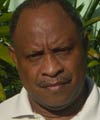 |
Leone Limalevu (left), Bill Aalbersberg, Patrina Dumaru and Tony Weir suggest some general lessons for community-based adaptation projects in a small developing country. |
| The authors' experience with projects in six Fijian villages suggests many lessons for community-based adaptation projects more generally. Community involvement is essential, support from outside groups is important and information about climate change and adaptation needs to be disseminated and shared. They also conclude that long-term monitoring, maintenance and evaluation is needed. | |
| Leone Limalevu and Tony Weir are researchers at the Pacific Centre for Environment and Sustainable Development of the University of the South Pacific, Suva, Fiji Islands. Bill Aalbersberg is director of the Institute of Applied Science at the University of the South Pacific. Patrina Dumaru is a research student of the University of Melbourne, Australia. | |
The small island developing countries of the Pacific are recognized as among those most vulnerable to climate change by both the United Nations Framework Convention on Climate Change and by the Intergovernmental Panel on Climate Change. They are already strongly impacted by extreme climatic events such as cyclones, to which the people have developed traditional coping mechanisms. Such mechanisms included preserved foods kept back for emergency use (for example, fermented breadfruit) and light-weight dwellings, which, though easily destroyed, could be quickly rebuilt. But economic development has led to changing lifestyles, urbanization and increased populations, making these mechanisms less relevant than in past centuries, and these countries do not have the human or financial resources to take up technologically sophisticated adaptation measures. There is a strong need, therefore, to identify, develop and disseminate adaptation strategies that are suitable for use in Pacific communities as they are now.
An article in issue 54 of Tiempo (January 2005), Vulnerability in Samoa, reported on a vulnerability and adaptation assessment for Saoluafata village in Samoa, carried out as part of a Pacific regional project sponsored by Canadian aid, called Capacity Building for Development of Adaptation Measures in Pacific Countries (CBDAMPIC). Although there were three CBDAMPIC project sites in Fiji, the Canadian funding ran out in 2005 before implementation progressed much beyond the planning phase. Consequently, the Fiji Government was keen to have some "demonstration" adaptation projects actually implemented, as were the communities concerned, their neighbours who might hope to emulate them and other agencies working in the region.
By this time, the University of the South Pacific (USP) had nearly ten years' experience in facilitating community development projects with an environmental focus, particularly in connection with Locally Managed Marine Areas. So the Fiji Department of Environment asked USP to bring this experience to bear on adaptation to two major impacts of climate change in the Pacific Islands: coastal management and water supply. The Australian Government agreed to fund pilot projects at six rural communities in Fiji. Provincial Councils within Fiji were asked to suggest communities who had already asked for assistance with one of these issues. A short-list of nine sites was selected, and then the project advisory board members visited the sites and recommended three "coastal" sites and three "water" sites to work with, mainly on the basis of the seriousness of their problem and their demonstrated willingness and ability to mobilize a communal effort.
The key outputs sought at each community were:
- enhanced community awareness about climate change impacts and adaptation;
- increased local capacity to assess and address climate change impacts and adaptation at the community level;
- climate change adaptation mainstreamed and internalized at the community level;
- discrete and sustainable adaptation measures implemented; and,
- continued "adaptive monitoring" beyond 2009.
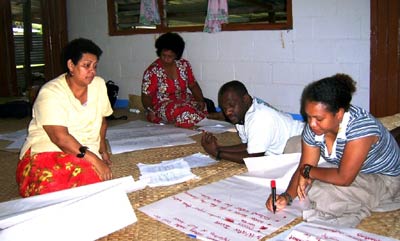 |
| One of several groups brainstorming options for action during a community meeting |
We placed strong emphasis on making sure that each community (assisted by USP) got to actually implement measures, not just think about them, and on these measures being sustainable in the sense that they would continue to be effective over time. To be sustainable in that sense requires also that they be environmentally sustainable (for example, won't lessen coastal erosion at location A by making it worse at neighbouring location B), economically sustainable (for example, not costly engineering works that other communities could not replicate or which would require expensive maintenance) and above all socially sustainable, becoming an integral part of the community's own routine practices and their internal social structures. Thus, some of the "measures" are simply processes rather than hardware, for example, agreement not to place new buildings close to an eroding riverbank or a procedure for rationing water supply.
In pursuit of these outcomes, it became apparent that rural communities such as these must be provided with a tool for vulnerability and adaptation assessment based on an approach to adaptation planning and implementation that integrates both climatic and non-climatic factors. The methodology developed by the Pacific Centre for Environment and Sustainable Development (PACE-SD) at USP for this purpose, the PACE-SD methodology, is an extension of that developed by the South Pacific Regional Environment Programme for the CBDAMPIC projects, but drawing on our experience with Locally Managed Marine Areas and on the United Nations Development Programme Adaptation Policy Framework of 2005.
The method assesses vulnerability and adaptation options through both community-based approaches using participatory tools and facilitator-based approaches using rigorous scientific tools and methods. Critically, the assessment and the plans are based on a firm understanding of the socio-economic, cultural and environmental problems currently faced by the community. They integrate climatic considerations into a broader framework of sustainable development as perceived by the community. Thus, significant problems related to climate extremes presently faced by the community are addressed first, since building resilience to these (as disaster risk management) automatically increases resilience to longer-term climate change.
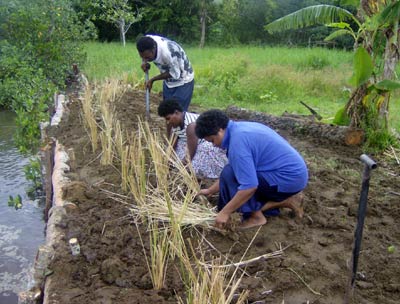 |
| Villagers planting vetiver grass at Buretu |
Each of the three coastal sites chosen already had a community coastal management plan. For these communities, the added process involved making communities aware of likely impacts of climate change on Fiji and discussed how their management plan priorities might change or new ones emerge with added knowledge. The impacts of climate change include: more intense rainfall and cyclones, sea-level rise and more frequent drought periods (El Niño-like conditions).
One of the new sites chosen was Buretu, a village in the delta of the Rewa river, which suffers from river bank erosion and from inundation whenever the river floods (which is currently once every two to three years). Actions adopted at Buretu include: infilling of eroded portions along the river bank; construction of bank protection structures using local materials; construction of walkways; planting of deep-rooted vetiver grass for bank stabilization; and assessment for drainage improvement works.
Bavu, a village on the "dry" (leeward) side of the main island, Viti Levu, has suffered from a shortage of clean fresh water, particularly in drought periods caused by El Niño. Actions adopted at Bavu include: rehabilitation of the borehole (which had been their main source of clean water); improvement of the rain harvesting system; and setting up of a pressurized reticulation system (using large tanks on higher ground, fed by the new borehole pump). The village plans also to rehabilitate a 40-year old small dam, which was polluted by major road works nearby.
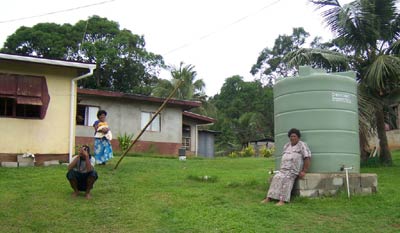 |
| New roof-fed communal water tanks at Bavu |
The village of Navukailagi is on the coast of a smaller island in Fiji, Gau, and is suffering from erosion of its coastline and also of the bank of a small stream that runs past the village but swells dramatically in storms. The village is addressing these problems by: planting coastal trees and mangroves (from a nursery they have established) along the coast; planting vetiver grass in appropriate places; and constructing a gabion retaining wall to prevent river bank erosion and simple perpendicular and vertical groynes to control coastal erosion.
Similar actions have been taken in the other three project villages.
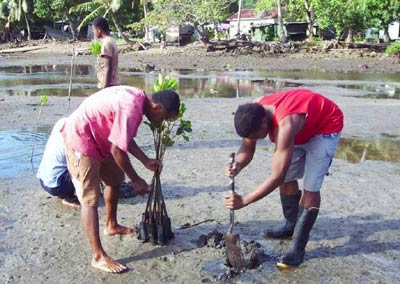 |
| Replanting mangroves at Navukailagi |
From our experience in working with these six villages (and from other community projects known to us), we have drawn lessons in four main areas.
First, community involvement is essential. Success is possible only with communities who recognize their need and are seeking help. Participation of the whole community in planning and implementation, including women and youth (maybe in differentiated roles), should be aimed for. The community should own the process. The planned activities should be in harmony with the community's work programme (timing, priorities, and so on). It is essential to be sensitive to the community structure and always ensure you work through it, not against it or be disruptive in any way. "Walking the extra mile" is usually required to ensure project success. Finally, patience is rewarded, haste is not.
Second, support from outside groups is important. Analysis and recommendations of experts should be incorporated into the project to avoid technical mistakes. Coordination with such expert organizations as the public works department is needed early on and the project should be mainstreamed into their planning. It is also necessary to coordinate with local government (for example, provincial offices), traditional structures and (where active) non-governmental organizations. Finally, capacity building can work both ways - as facilitators we have learnt a lot from the communities.
Third, information about climate change and adaptation needs to be disseminated and shared. Climate change awareness needs proper planning and should also be strategic in content and focus. Use of vernacular language and simple terms that people can relate to is critical. Climate change awareness should not be a one-off activity, but should be continued throughout the project so that the whole cross-section of the community have a good understanding of the issues. Information should be shared between similar projects and communities (for example, what worked or didn't). And a caution - information is taken up and acted on only by people who want to use it and have the capacity to do so.
Fourth, long-term monitoring, maintenance and evaluation is needed (over five to ten years). Evaluation should begin as early as possible and not be left to the end of the project. Adaptive monitoring is important: if something is visibly not working, do something about it. This means that some resources are required beyond the "end" of project.
These lessons can be summarized into an overall guiding rule: Have we done everything possible to make this project a sustainable contribution to community development?
We hope that projects in other small developing countries will find the lessons learnt here useful in making their projects more sustainable than might otherwise have been the case. With assistance from AusAID and other donors, USP is currently planning to extend these successful practices to other communities in Fiji and in other Pacific Island countries.
Further information
Leone Limalevu, Pacific Centre for Environment and Sustainable Development, University of the South Pacific, Private Mail Bag, Suva, Fiji Islands. Fax: +679-3232891. Email: limalevu_le@usp.ac.fj, weir_t@usp.ac.fj, aalbersberg@usp.ac.fj and dumaru_p@usp.ac.fj. Web: www.usp.ac.fj/pace/.
On the Web
The Tiempo Climate Cyberlibrary lists websites covering adaptation and Small Island Developing States.
Bright Ideas

General Electric plans to cut solar installation costs by half

Project 90 by 2030 supports South African school children and managers reduce their carbon footprint through its Club programme

Bath & North East Somerset Council in the United Kingdom has installed smart LED carriageway lighting that automatically adjusts to light and traffic levels

The United States National Oceanic and Atmospheric Administration and the American Public Gardens Association are mounting an educational exhibit at Longwood Gardens showing the link between temperature and planting zones

The energy-efficient Crowne Plaza Copenhagen Towers hotel is powered by renewable and sustainable sources, including integrated solar photovoltaics and guest-powered bicycles
El Hierro, one of the Canary Islands, plans to generate 80 per cent of its energy from renewable sources

The green roof on the Remarkables Primary School in New Zealand reduces stormwater runoff, provides insulation and doubles as an outdoor classroom

The Weather Info for All project aims to roll out up to five thousand automatic weather observation stations throughout Africa

SolSource turns its own waste heat into electricity or stores it in thermal fabrics, harnessing the sun's energy for cooking and electricity for low-income families

The Wave House uses vegetation for its architectural and environmental qualities, and especially in terms of thermal insulation

The Mbale compost-processing plant in Uganda produces cheaper fertilizer and reduces greenhouse gas emissions

At Casa Grande, Frito-Lay has reduced energy consumption by nearly a fifth since 2006 by, amongst other things, installing a heat recovery system to preheat cooking oil
Updated: May 15th 2015